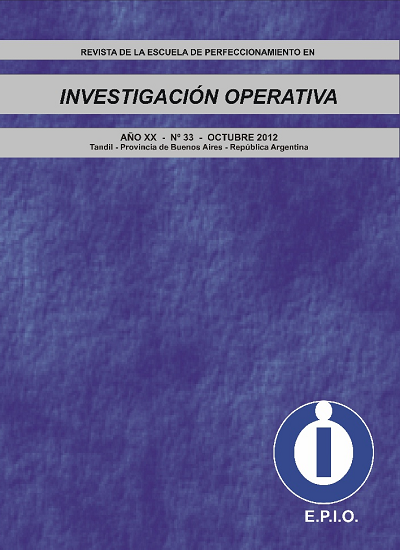Microarray analysis, pre-processing. Quality in the selection of differentiatedly expressed genes
Keywords:
microarrays, process optimization, quality improvementAbstract
Following the success of microarray technology, in the literature there is a large number of experiments made with them. However, the problems of standardization and the many sources of variability make it necessary posteriori validation techniques. For this reason, we have tried to study how the selection of genes influence some key preprocessing techniques. Many of the studies conducted to compare these techniques have been carried out on experiments which optimal results are known a priori to try to determine which has greater accuracy. In our case, we do not know the correct result a priori and what has been accomplished is a comparative analysis of the results obtained in each case in order to predict a priori the behavior of each of the techniques discussed in terms of various factors as initial data distribution, expression patterns object of interest, the presence of outliers, and so on.
Three techniques have been applied on the preprocessing on a microarray experiment. The techniques are GCRMA, MAS5 and MBEI. In our data there have been found mainly three patterns of expression in those genes expressed and have been shown statistically that there is an association between the pre-processing technique used and the predominant pattern in it. This trend is related to efficiency in the detection of outliers and the magnitude of change detected with each of them. So far, it has not been able to establish a statistically significant in confirming the agreement between the three methods after the selection of differentially expressed genes.
Downloads
References
AFFYMETRIX, (2002): “STATISTICAL ALGORITHMS DESCRIPTION DOCUMENT”. Technical Report, Affymetrix, Santa Clara, CA.
ARIAS-CASTRO, E. CANDES, E. J., AND PLAN, Y., (2010): “GLOBAL TESTING AND SPARSE ALTERNATIVES: ANOVA, MULTIPLE COMPARISONS AND THE HIGHER CRITICISM”. AR-XIV:1007.1434.
BREMER, M., HIMELBLAU, E. AND MADLUNG, A., (2010): “STATISTICAL METHODS IN MOLECULAR BIOLOGY”. METHODS IN MOLECULAR BIOLOGY, 620(3):287-313.
BUTTE, A. J., (2009): “BIOINFORMATIC AND COMPUTATIONAL ANALYSIS FOR GENOMIC MEDICINE. ESSENTIALS OF GENOMIC AND PERSONALIZED MEDICINE, CHAP. 10”. HUNTINGTON F. WILLARD AND GEO_REY S. GINSBURG, ELSEVIER, ACADEMIC PRESS.
CALZA, S., VALENTINI, D., AND PAWITAN, Y., (2008): “NORMALIZATION OF OLIGONUCLEOTIDE ARRAYS BASED ON THE LEAST-VARIANT SET
OF GENES”. BMC BIOINFORMATICS, 9(1):140.
DALGAARD, P., (2008): “INTRODUCTORY STATISTICS WITH R”. SPRINGER, 2ND EDITION.
DE BIN, R. AND RISSO, D., (2011). “A NOVEL APPROACH TO THE CLUSTERING OF MICROARRAY DATA VIA NONPARAMETRIC DENSITY ESTIMATION”. BMC BIOINFORMATICS, 12:49.
DE HAAN, J.R., WEHRENS, R., BAUERSCHMIDT, S., PIEK, E., VAN SCHAIK, R. AND BUYDENS, L.M.C. (2007): “INTERPRETATION OF
ANOVA MODELS FOR MICROARRAY DATA USING PCA”. BIOINFORMATICS 2007, 23:184-190.
ELASHOFF, M., ALVARES, C. AND LAUREN, P., (2009): “METHOD AND SYSTEM FOR MANAGING AND QUERYING GENE EXPRESSION DATA
ACCORDING TO QUALITY”. US PATENT 7,558, 411, 2009.
GAN, G., MA, C. AND WU, J. (2009): “DATA CLUSTERING: THEORY, ALGORITHMS, AND APPLICATIONS”. SIAM, SOCIETY FOR INDUSTRIAL
AND APPLIED MATHEMATICS.
IRIZARRY, R.A., WU, Z. AND JA_EE, H.A., (2006): “COMPARISON OF AFFYMETRIX GENECHIP EXPRESSION MEASURES”. BIOINFORMATICS
22, 789-794.
LI, C. AND WONG, W. H., (2001A): “MODEL-BASED ANALYSIS OF OLIGONUCLEOTIDE ARRAYS: EXPRESSION INDEX COMPUTATION
AND OUTLIER DETECTION”. PROC NATL ACAD SCI U S A, 98(1):31-36.
LI, C. AND WONG, W. H., (2001B): “MODEL-BASED ANALYSIS OF OLIGONUCLEOTIDE ARRAYS: MODEL VALIDATION, DESIGN ISSUES
AND STANDARD ERROR APPLICATION”. GENOME BIOL, 2(8):RESEARCH0032.
MUIR, W.M. ROSA, G.J.M., PITTENDRIGH, B.R., XU, Z., RIDER, S.D. , FOUNTAIN, M. AND OGAS J., (2009): “A MIXTURE MODEL APPROACH
FOR THE ANALYSIS OF SMALL EXPLORATORY MICROARRAY EXPERIMENTS.COMPUTATIONAL”. STATISTICS AND DATA ANALYSIS, 53:1566-1576.
NAEF, F., AND MAGNASCO, M. O., (2003): “SOLVING THE RIDDLE OF THE BRIGHT MISMATCHES: LABELING AND ELECTIVE BINDING IN OLIGONUCLEOTIDE ARRAYS”. PHYSICAL REVIEW E 68, 011906.
NEPOMUCENO, J.A., TRONCOSO, A., AGUILAR-RUIZ, J.S., (2011): “BICLUSTERING OF GENE EXPRESSION DATA BY CORRELATIONBASED
SCATTER SEARCH”. BIODATA MIN., 4(1):3.
RAUCH, G., GEISTANGER, A., TIMM, J., (2011): “A NEW OUTLIER IDENTI_CATION TEST FOR METHOD COMPARISON STUDIES BASED ON ROBUST REGRESSION”. JOURNAL OF BIOPHARMACEUTICAL STATISTICS, 1520-5711, 21(1):151-169.
SORIN DRAGHICI, (2003): “DATA ANALYSIS TOOLS FOR DNA MICROARRAYS, 2A ED”. CHAPMAN & HALL/CRC, 2003.
WU, Z., IRIZARRY, R. A., GENTLEMAN, R., MURILLO, F. M., AND SPENCER, F., (2003): “A MODEL BASED BACKGROUND ADJUSTMENT FOR OLIGONUCLEOTIDE EXPRESSION ARRAYS”. TECHNICAL REPORT WORKING PAPER1, JOHNS HOPKINS UNIVERSITY, DEPT. OF BIOSTATISTICS WORKING PAPERS.
Downloads
Published
Issue
Section
License
Atribución — Usted debe dar crédito de manera adecuada, brindar un enlace a la licencia, e indicar si se han realizado cambios. Puede hacerlo en cualquier forma razonable, pero no de forma tal que sugiera que usted o su uso tienen el apoyo de la licenciante.
NoComercial — Usted no puede hacer uso del material con propósitos comerciales.
CompartirIgual — Si remezcla, transforma o crea a partir del material, debe distribuir su contribución bajo la misma licencia del original.







